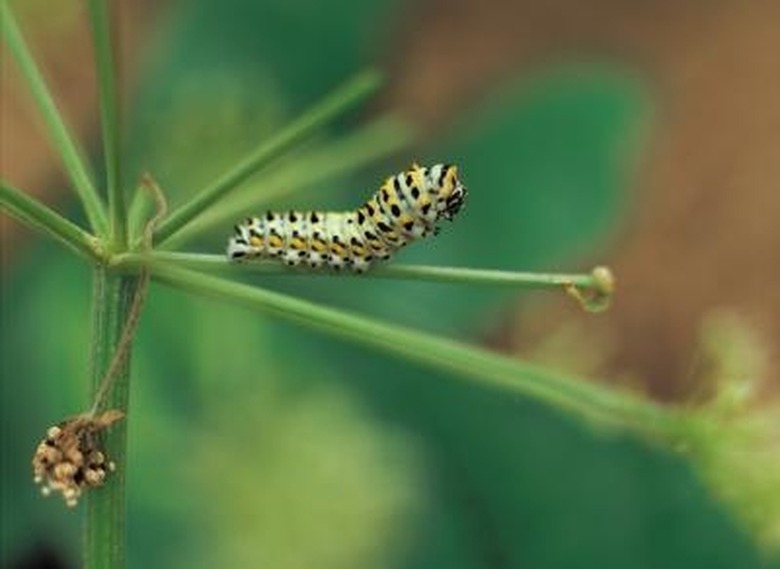Dill Plant Pests
Step 1
Parsleyworms are 2-inch, green caterpillars with black bands dotted with yellow across each segment. When disturbed, they project a pair of smelly, orange horns in hopes of frightening predators. They usually appear in small numbers, but when numerous they cause substantial damage by eating dill leaves. If the damage is minimal, consider sharing your garden with parsleyworms, which transform into beautiful black swallowtail butterflies.
Tomato Hornworms
Step 1
Tomato hornworms are 3- to 5-inch green caterpillars with white stripes. They get their name from a horn that projects from their rear. These caterpillars mature into large moths known as sphinx, hawk or hummingbird moths. Tomato hornworms have a strong preference for dill, and dill is sometimes used as a trap crop to lure the caterpillars away from vegetable crops. They can quickly defoliate dill plants, so try to catch them early.
Step 2
- Parsleyworms are 2-inch, green caterpillars with black bands dotted with yellow across each segment.
- They usually appear in small numbers, but when numerous they cause substantial damage by eating dill leaves.
Caterpillar Control
Step 1
Control parsleyworms and tomato hornworms by handpicking and with insecticides containing Bacillus thuringiensis, or Bt. Parsleyworms are easy to spot because of their distinctive coloring, and tomato hornworms are so big that they are hard to miss. You can remove tomato hornworms with tongs if you prefer not to touch them, but parsleyworms are so small that some gardeners find them hard to pick up with tongs. If the caterpillars are too numerous to control by handpicking, use an insecticide containing Bt, which is a bacteria that is fatal to caterpillars but harmless to humans, pets and other wildlife. Always follow the label instructions when using insecticides.
Aphids
Step 1
Aphids sometimes infest dill plants. Aphids are tiny, pear-shaped, soft-bodied insects that feed on dill leaves by sucking out sap. They leave yellow and brown spots on the foliage and deposits of a sticky substance called honeydew. Honeydew becomes infested with sooty mold, which turns it black. Aphids are generally kept in check by beneficial insects, and since dill attracts beneficial insects, the aphids rarely get out of control. Avoid using systemic insecticides since they are better at killing beneficial insects than aphids. Insecticides that contain insecticidal soap are usually effective if the infestation is caught early. Use insecticidal soap every two or three days for two weeks.
Step 2
- Control parsleyworms and tomato hornworms by handpicking and with insecticides containing Bacillus thuringiensis, or Bt.
- You can remove tomato hornworms with tongs if you prefer not to touch them, but parsleyworms are so small that some gardeners find them hard to pick up with tongs.
References
- Colorado State University Extension; Parsleyworm; Whitney Cranshaw
- "Rodale's Garden Problem Solver"; Jeff Ball; 1988
- Missouri Botanical Garden: Anethum Graveolens

